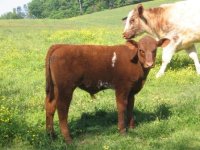I understand that ET calves can throw some issues into how EPDs are calculated , but to me, they should be relatively close, at least until calves from each of them enter the system. I did speak with Greg about this, and he did mention that they were having some problems with Canadian born ET calves. I mentioned to him that both the sire and dam of these calves are registered in the ASA herdbook. He said the EPDs should have been calculated the same way they would be if they had been US born then.
I found Greg to be very helpful and he said he was going to take this issue up with Colorado State, who are now doing the ASA EPD calculations. That was over a month ago, and I have not had any more information, until yesterday when I received the EPDs for my entire 2007 calf crop. In looking at the numbers on my calves, I really have to question many of them. That said, how am I supposed to believe any of them are correct, when we have such a spread in the numbers between 3 full sibs. Here are the EPDs for both sire and dam:
CE BW WW YW Milk
Sire -12.1 9.6 26 37 2
Dam - 1.8 3.2 16 24 8
The CE EPD for both sire and dam are both negative numbers, yet all three calves are 0 to + 4.7 for this trait. BW EPDs are +9.6 to +3.2 for sire and dam yet these 3 full sibs are between -0.4 to 4.6. All other EPDs for other traits show similar variations.
These EPD numbers are confusing enough, but I am having majpr issues with almost all the EPDs generated on our 2007 calf crop. As I mentioned before, we had many bulls from widely different bloodlines, with identical EPDs for each and every trait. That hardly seems possible to me!
I know of another Canadian breeder who has been trying to develop a herd with great EPDs. He has been very disappointed with the EPDs his calves have been receiving despite being from some US genetics that have excellent numbers. Many of his sires and dams are American based in their genetic make up. He had never been able to get EPDs anywheres close to what the sire and dam had, on his calves. Last fall after he received his EPDs on his calves, he registered all the dams in the ASA herdbook and re- submitted the same data on his calves for EPD calculations again. When he received his EPDs ( for the second time) his Numbers were signifigantly better. This again suggests to me that something is screwy in the EPD system. To me, an EPD should be the same, no matter where it is born, providing it is the same breed. I can understand some discrepencies if there are no records in the system for some of the parents bloodlines. In the cases I have mentioned here, almost all parents are ASA registered, yet there is major variations in the EPDs generated.
I am concerned about this, as EPDs are an extremely important tool in generating sales especially to other countries. We need to have a EPD system that we can believe in and it should not lead one to question if it is accurate or not. Right now, I question the system when I look at my numbers. Maybe I am the only one who has had these issues, I do not know.

